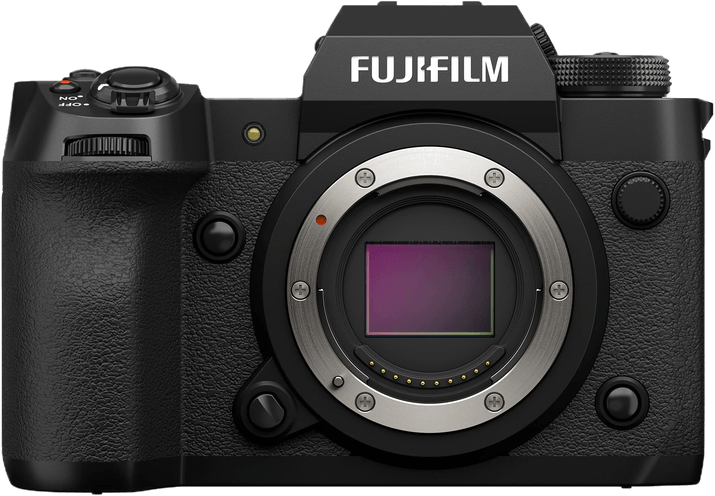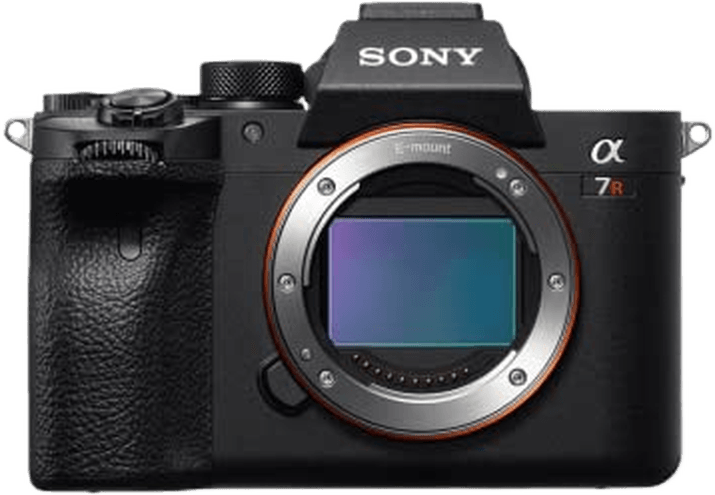Fujifilm X-H2 vs Sony a7R IV Comparison
Fujifilm X-H2

Sony a7R IV

The Sony a7R IV edges out the Fujifilm X-H2 with a score of 84/100 compared to 82/100. Both cameras are mirrorless and share similar dimensions and weight. The X-H2 measures 136 x 93 x 95mm and weighs 660g, while the a7R IV is 129 x 96 x 78mm and 665g.
The Fujifilm X-H2 has a more attractive launch price of $1999, making it more affordable than the Sony a7R IV at $3500. However, the a7R IV’s higher score suggests it offers better performance and features despite its higher cost.
Though the X-H2 was released in 2022, three years after the a7R IV’s 2019 release, it couldn’t surpass the latter’s performance. The Sony a7R IV remains a strong contender in the mirrorless camera market, while the Fujifilm X-H2 provides a more budget-friendly option without compromising on quality.
Fujifilm X-H2 vs Sony a7R IV Overview and Optics
The Sony a7R IV outperforms the Fujifilm X-H2 in optics, scoring 85/100 compared to the X-H2’s 81/100. Both cameras share several specifications, such as CMOS sensors, image stabilization, and lens mounts specific to their respective brands. However, there are notable differences that contribute to the Sony a7R IV’s higher score.
The Sony a7R IV has a significant advantage in megapixels, boasting 61.2 compared to the X-H2’s 40. This results in sharper, more detailed images. Additionally, the a7R IV has a full-frame sensor, which is larger than the X-H2’s APS-C sensor. A larger sensor generally leads to better image quality, particularly in low light situations. The Sony a7R IV also has a DXOMARK score of 99 for its sensor, which is a reliable indicator of its superior performance.
On the other hand, the Fujifilm X-H2 has a faster shooting speed of 15 frames per second, compared to the a7R IV’s 10. This makes the X-H2 more suitable for capturing fast-moving subjects and action shots. Furthermore, the X-H2 is equipped with the X-Processor 5, a powerful and efficient processor that ensures optimal performance.
Despite these advantages, the Fujifilm X-H2 falls short in terms of optics when compared to the Sony a7R IV. The a7R IV’s higher megapixel count, full-frame sensor, and impressive DXOMARK score set it apart as the superior choice for photographers seeking the best image quality.
While both cameras have their merits, the Sony a7R IV ultimately takes the lead in optics. Its higher score reflects its outstanding performance in image quality, making it the preferred choice for photographers who prioritize sharp, detailed images.
Fujifilm X-H2 vs Sony a7R IV Video Performance
The Fujifilm X-H2 emerges as the winner in terms of video capabilities, with a score of 83 out of 100, compared to the Sony a7R IV’s score of 70. Both cameras share some common specifications, such as a maximum video resolution of 4K and dimensions of 3840 x 2160. Additionally, both cameras have built-in time-lapse functionality.
The Fujifilm X-H2 outperforms the Sony a7R IV in one crucial aspect: the maximum video frame rate. The X-H2 can capture video at a rate of 60 frames per second (fps), while the a7R IV’s maximum frame rate is 30fps. This means that the X-H2 can record smoother and more detailed footage, particularly when capturing fast-moving subjects or utilizing slow-motion effects.
On the other hand, the Sony a7R IV has no specific advantages over the Fujifilm X-H2 in terms of video capabilities. Both cameras offer the same resolution and time-lapse features, with the X-H2 taking the lead in frame rate capabilities.
Considering the 13-point difference in video scores and the higher frame rate offered by the Fujifilm X-H2, it is the superior choice for videographers. The X-H2 provides smoother footage and greater creative possibilities for capturing motion and action. Meanwhile, the Sony a7R IV falls short in this category, despite sharing some common features with the X-H2. Ultimately, those seeking a camera with strong video capabilities should opt for the Fujifilm X-H2 over the Sony a7R IV.
Fujifilm X-H2 vs Sony a7R IV Features and Benefits
The Fujifilm X-H2 triumphs over the Sony a7R IV with a feature score of 85/100, compared to the Sony’s 83/100. Both cameras share several specifications, including a 3-inch screen size, touchscreen capability, flip screen, and the absence of GPS. Additionally, both cameras are equipped with WIFI and Bluetooth connectivity.
The Fujifilm X-H2 takes the lead with its superior screen resolution of 1,620,000 dots, which surpasses the Sony a7R IV’s 1,440,000 dots. This higher resolution provides clearer and sharper display, allowing for more precise image review and menu navigation.
Although the Sony a7R IV falls short in screen resolution, it remains a strong competitor with its own unique advantages. It is important to consider other factors, such as sensor quality, lens compatibility, and overall performance when making a final decision.
Both the Fujifilm X-H2 and the Sony a7R IV have their strengths and weaknesses. The Fujifilm X-H2 boasts a higher feature score and screen resolution, while the Sony a7R IV remains a worthy opponent with its own merits. Ultimately, the choice between these two cameras depends on individual preferences and specific needs.
Fujifilm X-H2 vs Sony a7R IV Storage and Battery
The Fujifilm X-H2 and Sony a7R IV both receive a storage and battery score of 79/100. These cameras share common specifications, such as having two memory card slots and USB charging capabilities. The X-H2 accepts CFexpress Type B and SD (UHS-II compatible) cards, while the a7R IV takes SD, SDHC, and SDXC (UHS-II compatible) cards.
The Fujifilm X-H2 has a slight advantage in battery life, offering 680 shots per charge with its NP-W235 battery, compared to the Sony a7R IV’s 670 shots using the NP-FZ100 battery. This difference may not be significant for most users, but it is worth considering for those who require extended shooting sessions.
On the other hand, the Sony a7R IV provides more versatility in memory card compatibility, accepting SD, SDHC, and SDXC cards. This may be an advantage for photographers who already own a variety of SD cards and do not wish to invest in new CFexpress Type B cards.
Considering the storage and battery aspects, both cameras perform similarly, with the Fujifilm X-H2 offering slightly longer battery life and the Sony a7R IV providing greater memory card compatibility. Users should weigh these factors according to their individual needs and preferences when choosing between these two cameras.
Fujifilm X-H2 vs Sony a7R IV – Our Verdict
Are you still undecided about which camera is right for you? Have a look at these popular comparisons that feature the Fujifilm X-H2 or the Sony a7R IV:

